
Rediscovering Japan

Rediscovering Japan
Travel (Eastern Yamaguchi (Iwakuni, Yanai))

by tomizuta
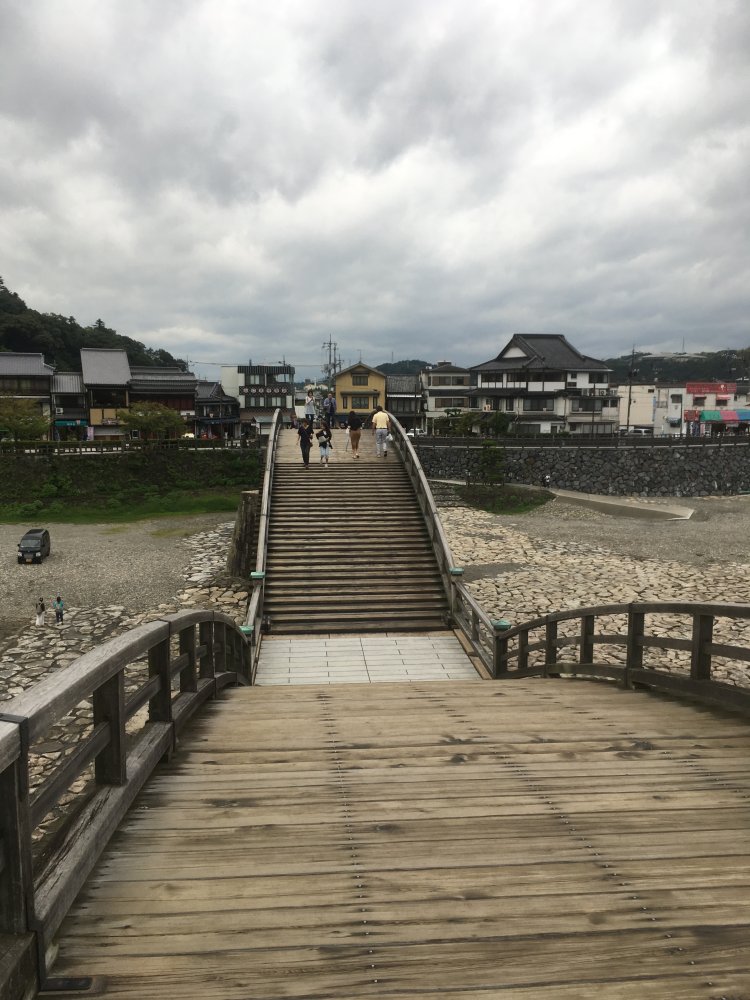
Kintaikyou (Kintai Bridge) is a historical wooden arch bridge built in 1673, across the Nishiki River linking Iwakuni Castle with the township. A view of the township from the castle side.
I wrote of the custom to visit the family graves around spring and autumn equinox (ohigan). Ohigan means the other world (the paradise where the ancestors dwell) as opposed to shigan meaning this side of the world (the earth that we dwell). On spring and autumn equinox when day and night is equal, it is believed in Buddhism that that is when the two worlds are closest, and best days to pay respect to our ancestors. Also the third Monday in September is Respect the Elderly Day, a national holiday. So I usually visit relatives in Hiroshima around this period and taking the opportunity, spend a day or two in the neighboring areas. One place that I had never visited was Kintaikyou (Kintai Bridge), which is one of the three most famous bridges in Japan. So from September 16th to 18th we visited Iwakuni City to see this famous bridge. Iwakuni City is on the south eastern part of Yamaguchi Prefecture bordering Hiroshima Prefecture. From the city center of Hiroshima, it is an hour drive south west to Iwakuni City.
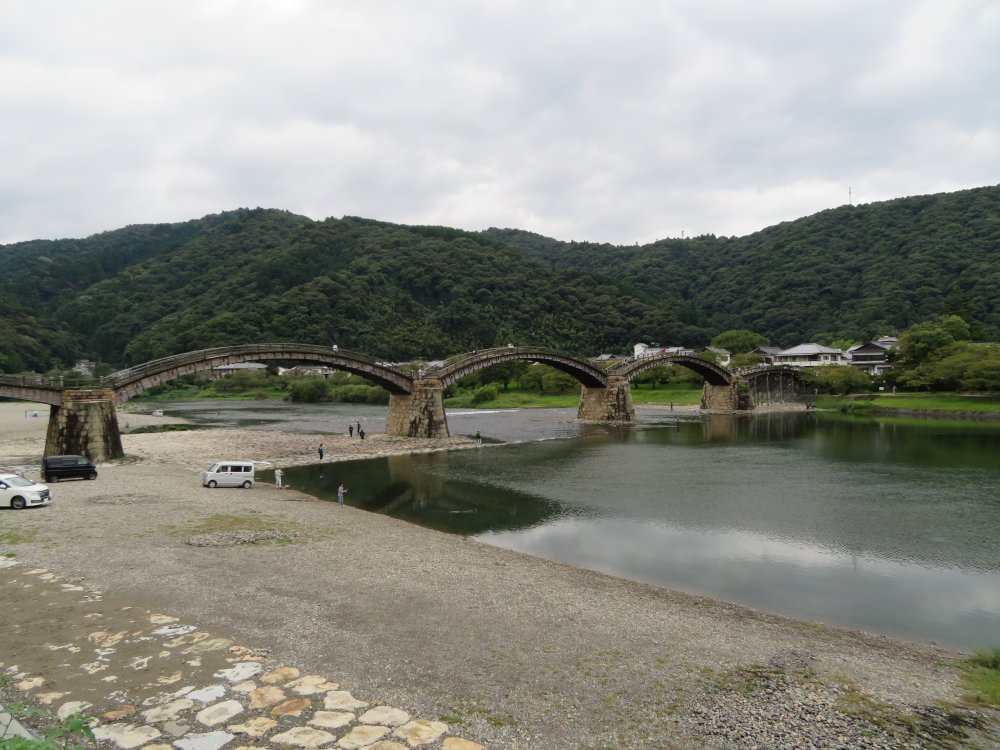
The bridge has a width of five meters and a length of two hundred meters.
Kintaikyou or the Kintai Bridge is a historical wooden arch bridge built
in 1673, across the Nishiki River linking Iwakuni Castle with the township.
The bridge has a width of five meters and a length of two hundred meters.
The arches were periodically refurbished and remained intact until washed
away in 1950 by flooding caused by a typhoon. The bridge was reconstructed
in 1953 in its original form.
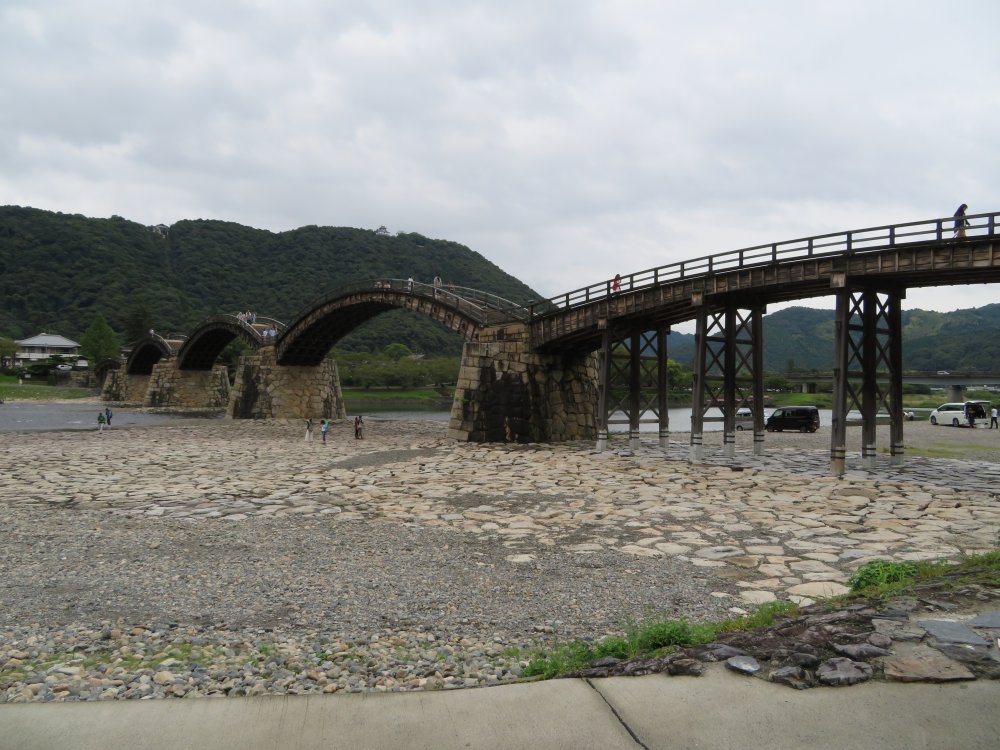
Admire the bridge from the river banks underneath.
September is a month when typhoons strike Japan. In Japan we number typhoons as they are born. On September 16th Typhoon No.18 was approaching from the south west. Upon arrival at the hotel in front of the bridge at around five pm, we were told that the bridge would be closed the following day, as heavy wind and rain was forecast from the afternoon. So immediately after checking in, we made a quick visit to Kintaikyou. You have to pay three hundred yen as the admission fee to the bridge. If you are planning to visit Iwakuni Castle, it is best that you buy a package ticket that includes the admission fees to the bridge, ropeway and the castle. The package ticket is only valid for the day of issue, so it isn’t worth it if you aren’t planning to visit all three in the same day. I also asked if it was possible to visit the castle other than by ropeway the answer to which was no. The length of the bridge is only two hundred meters, so an hour should be enough for you to go make a return trip to the other side. Admire the scenery from the bridge as well as the bridge itself from the river banks underneath.
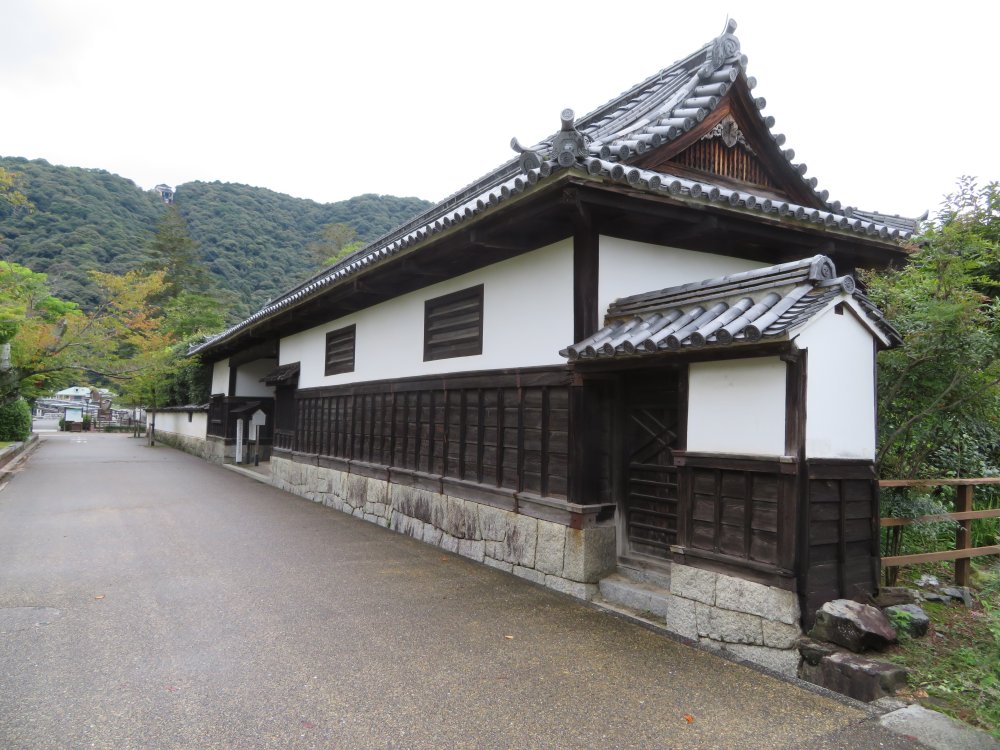
The former Kikkawa residential area is now a park with museums and historic buildings. The entrance building of the Kagawa family, a high ranking subordinate of the Kikkawas.
Iwakuni was a small fiefdom in the south eastern part of Yamaguchi Prefecture. The feudal lord in the Edo era was the Kikkawa family. The Kikkawa family was a subordinate of the powerful Mouri family that ruled a vast area of the western Chugoku district. Upon the Sekigahara War that divided the country into the west (supporters of the Toyotomi) and east (supporters of the Tokugawa) in the early 17th century, Hiroie Kikkawa, recognizing the eventual victory of the Tokugawa acted as the go-between with the Tokugawa and pleaded on Mouri’s behalf after the war. Hiroie became the first feudal lord of Iwakuni. He was still regarded as a subordinate by the Mouri but was recognized as a partly independent feudal lord by the Tokugawa shougun, such that the feudal lord had the privilege as well as obligation of periodically visiting the shogun in Edo Castle. The frequency of the visit varied, some every six months to some in the farthest areas every couple of years. We learned that the Kikkawas had petitioned for more than two hundred fifty years to be promoted to a proper feudal lord which was finally granted in 1868 which lasted for just over two years till all fiefdoms were abolished by the Meiji Government in 1871. I learned that when the feudal lords passed Kitaikyou in their back and forth visits to Edo Castle, they did not lower their spears in respect of the fiefdom they were passing which was the custom out of respect as Iwakuni was not recognized as a proper independent fiefdom. So the people of Iwakuni planted pine trees that spread across the bridge forcing the passing feudal lord’s followers to lower their spears. Indeed, the tragedy and pride of the people of Iwakuni for not being recognized as a proper fiefdom is a common theme for this city as I will explain later.
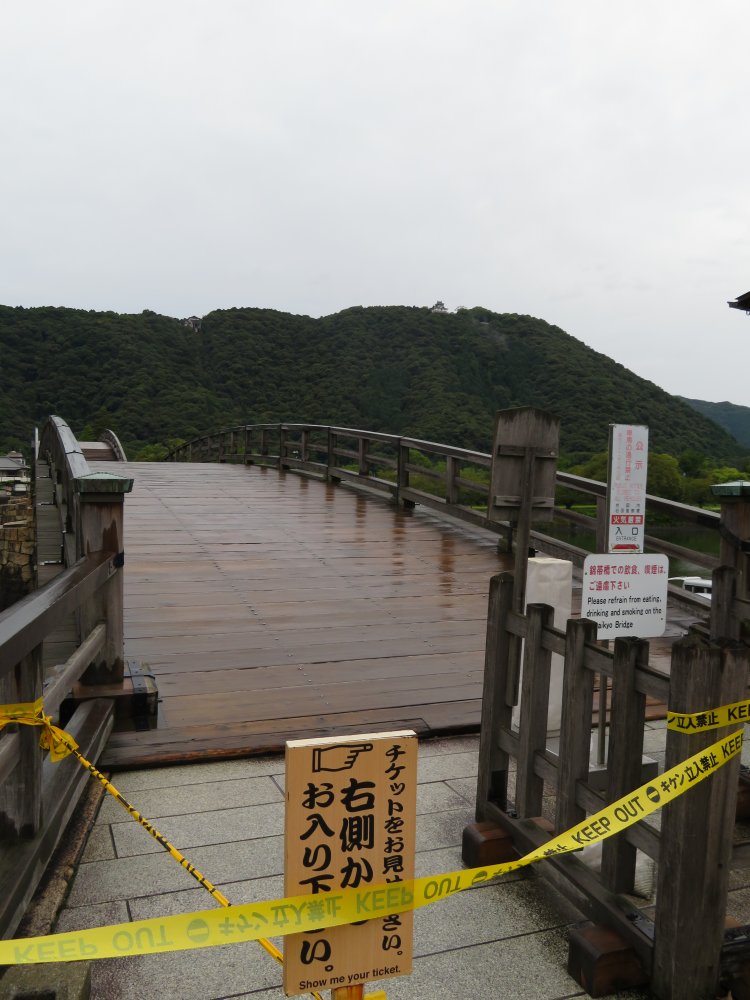
Kintaikyou was closed. From the edge of the bridge, I got to understand how Kintaikyou linked the Kikkawa residential area(behindthe bridge) and Iwakuni Castle(in the far back).
Iwakuni Castle was dismantled in 1615 only seven years after its completion by order of the Tokugawa Government prohibiting fiefdoms to have multiple castles. Iwakuni had a castle on top of a mountain as well as the bottom the latter of which served as the normal residence of the Kikkawas. Prohibition to have multiple castles was not always strictly enforced so some feudal lords powerful or close to the shogunate were allowed exceptions. There was no such leniency to the Kikkawas. I understand the people of Iwakuni took solace to the fact they had another landmark, Kintaikyou. The following morning the rain clouds had not reached Iwakuni yet, so I made a quick visit to Kintaikyou which was closed as pre-advised. But from the edge of the bridge, I managed to get a better understanding of how Kintaikyou, the Kikkawa residential area and Iwakuni Castle (reconstructed in 1962) were linked.
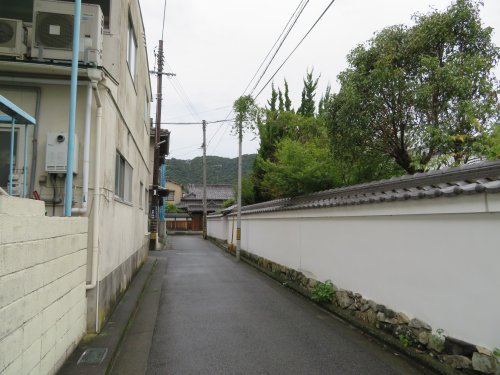
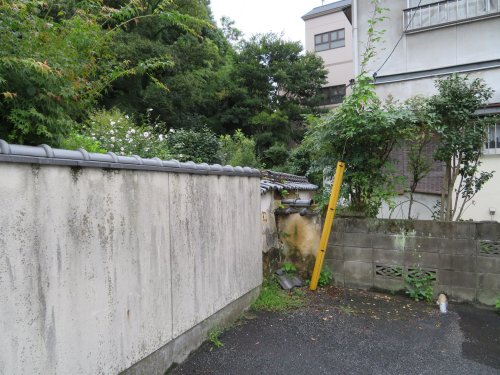
Compared with townships such as Hita, there aren’t that many buildings that have been preserved to date.
I had planned to visit the castle area (in particular the museums and historic
samurai residences in and around the former lower castle grounds) first
and then the township on the opposite side. Unfortunately we found that
the Kikkawa Museum on the castle side was closed because of the approaching
typhoon. So we went to explore the old township after breakfast. Merchant
shops and some lower ranking samurai residences formerly stood in the township.
Compared with townships such as Hita, there aren’t that many buildings
that have been preserved to date. Iwakuni was a very rural area until industrialization
started in the 1930s from artificial silk production. In 1940 Iwakuni Airport
was constructed as a military airport for the Japan Navy which led to heavy
bombing of Iwakuni in 1945. After the war the first petroleum complex in
Japan was constructed in the area. The rapid industrialization led to the
loss of many historical buildings. One place I had penciled to see was
the Iwakuni School Museum. This School located at the very end of the old
township was constructed in 1870 and opened in 1871. The Meiji government
put strong emphasis on education to catch up with the Western countries
and enacted an act introducing compulsory education in 1872. The opening
of Iwakuni School predates this. As an early school building Iwakuni School
is unique in having a completely Japanese style with a Western style third
floor added on top of the two original stories later on. One early example
of a Meiji school is Kaichi School in Matsumoto, Nagano completed in 1876
which is of a completely Western style.
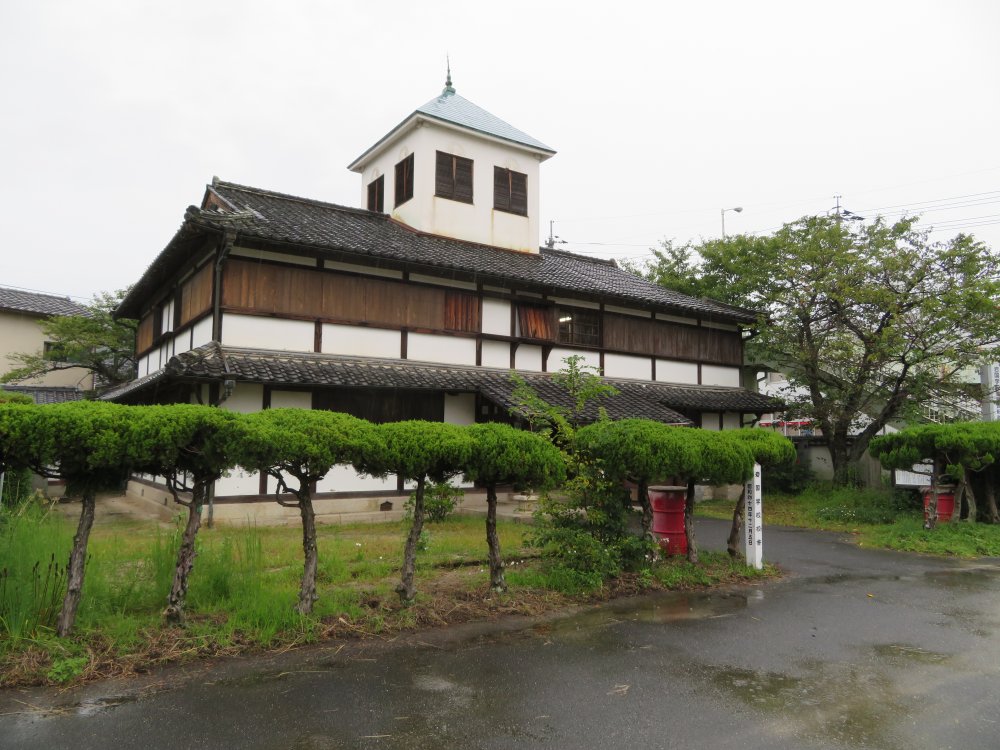
Iwakuni School is unique in having a completely Japanese style with a Western style third floor added on top of the two original stories later on.
It had started to rain when we arrived at the School Museum. “Is the museum open?” I asked the lady curator. “Yes we are open. “ “Even though the typhoon is approaching and heavy wind and rain is predicted? The museums on the other side of the bridge were closed.” “The Choukokan Museum should be open. We are part of Choukokan and will be open unless we receive instructions to close. Welcome to the museum. I thought we would have no visitors today.” Us being the sole visitors, she guided us through the museum. The first room on the ground floor displayed pictures of people of prominence from Iwakuni that had attended this school. She spent a long time talking about Ichisuke Fujioka who became a co-founder of Toshiba and Tokyo Electric and is recognized as the father of electricity. She proudly told us how Fujioka founded the first municipal tram in Iwakuni, predating the larger city of Hiroshima. The pride of the people of Iwakuni that had long been recognized as only a second class fiefdom was so apparent. The other room on the ground floor displayed text books from the Edo era to the early post WWII years. The display was so extensive that I’d never seen before. The curator proudly told us that scholars from the universities visit this museum for study. The upper floor had displays of old farming and traditional crafts. There was a papermaking tool in the corner. The curator advised that Japanese paper making once a popular industry had now disappeared. “There were a lot of historical buildings in the area. They’ve been replaced by convenience stores, pachinko amusement halls and modern buildings. We used to have a lovely police station that has been reconstructed.” “I noticed a miniature samurai residence on top of the 7/11 convenience store. Now I understand why.”
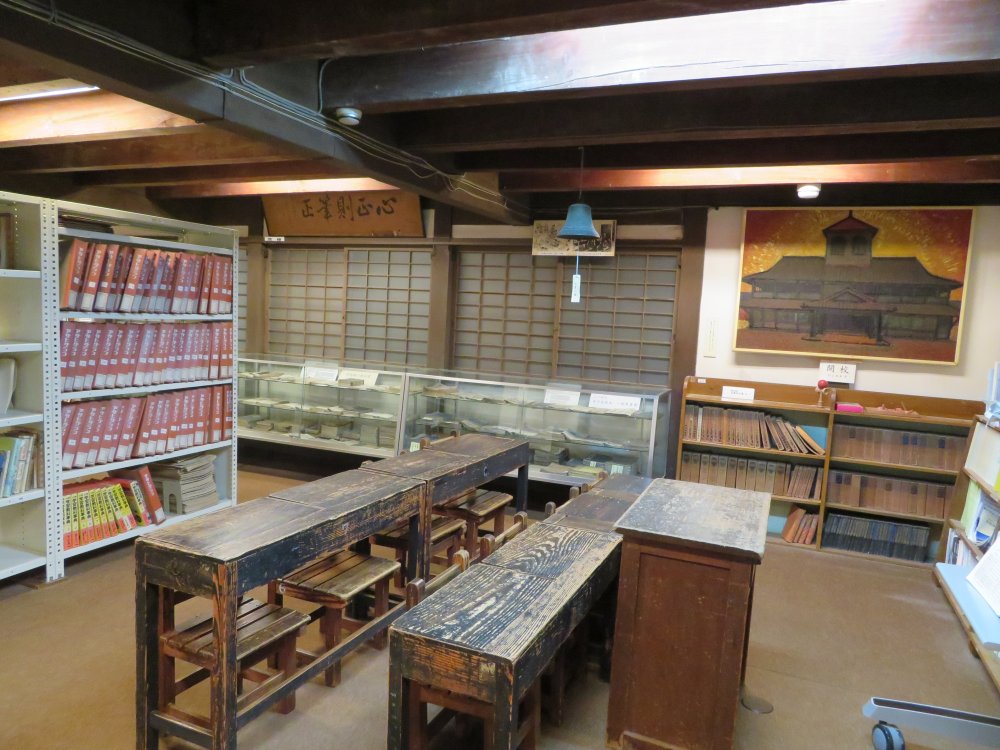
Room on the ground floor with an extensive display of elementary school text books from the Edo era to the early post WWII years (showcase in the back). Old wooden school desk and chairs (in front).
We had planned to visit the neighboring city of Yanai the following day. But we changed our plan and drove to Yanai City about thirty kilometers south as we thought we might lose the opportunity given the approaching typhoon. Yanai City is a port town south of Iwakuni City. It was part of the Iwakuni fiefdom in the Edo era. It flourished in the Edo era as a collection point of local produce. The merchant district with its white-walled shops was designated in 1984 as an Important Preservation District for Groups of Historic Buildings, one of the oldest of such designations. In contrast to Iwakuni that saw rapid industrialization, was on the JR Sanyou Line and linked by highways, Yanai had been left out which explains why the old merchant area has remained very much intact. It is famous for its white walled merchant buildings which have become a huge tourist attraction.
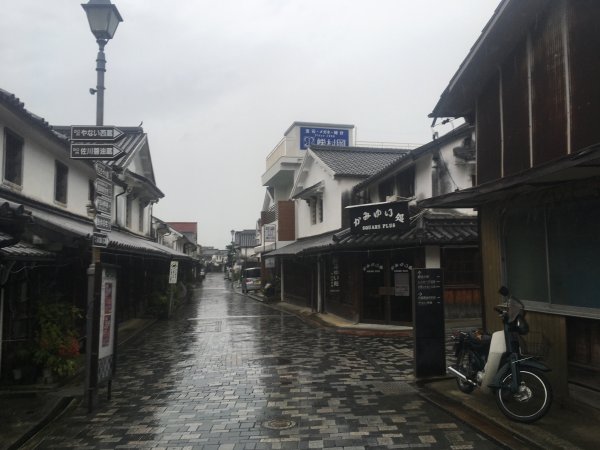
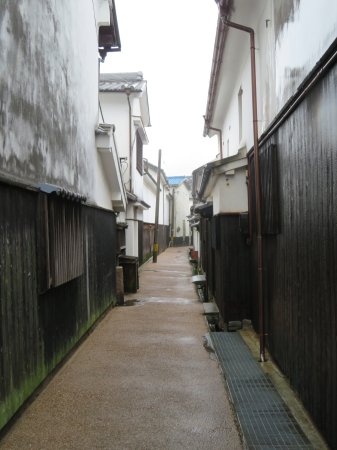
(Left) There were no visitors to Yanai's famous white-walled merchant high street. (Right) An alley stemming from high street where the money lenders were located.
It was pouring when we got to the historic merchant area. This is a high
street that runs about 200 meters with merchant shops from the Edo era
on both sides. Unfortunately almost all the shops as well as the residence
open to the public were closed. The area had flourished in the Edo era
as a collection and trading point for local produce, vegetable oil in particular.
Sweet soy sauce making continues to this day. My wife noticed a pleasant
aroma of soy sauce but the soy sauce shops were all closed. The information
center at the coach car park (which was completely vacant that day) was
open, so I asked if they knew of anywhere that might be open and had this
local soy sauce. I was told to try a sweets shop not far from the eastern
end of the merchant shop area.
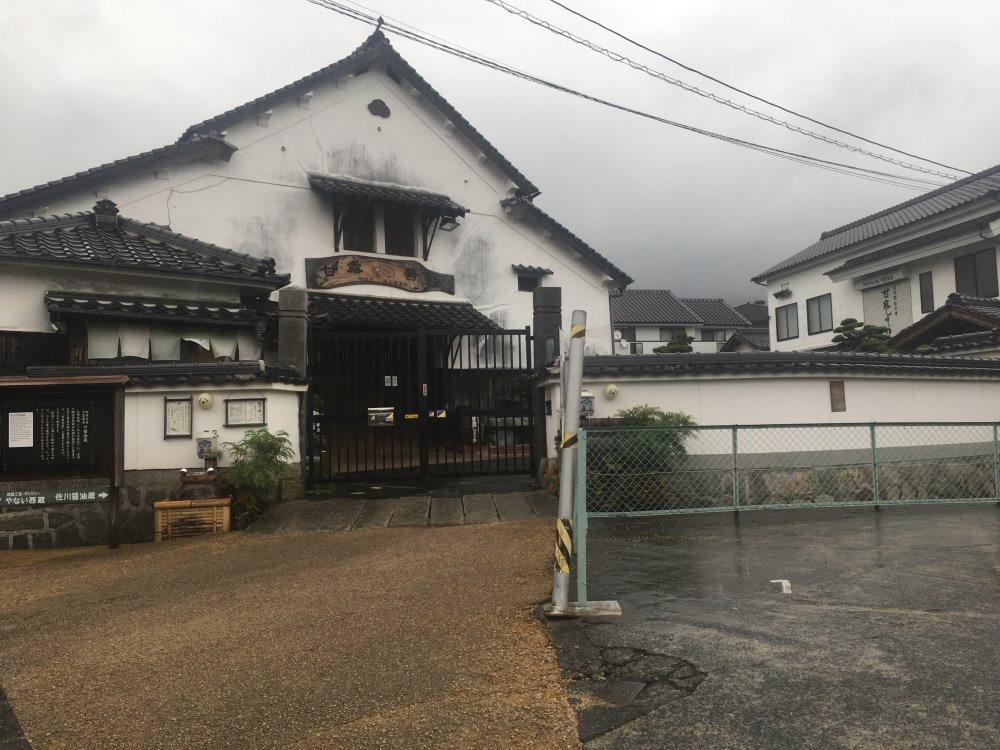
A soy sauce factory of high street. Unfortunately all soy sauce factories in the area were closed because of the approaching typhoon.
Luckily the shop was open, but there was no one to be seen. After a while
the shop lady said “Oh I’m so sorry. I thought there would be no customers
and was occupied in the store room.” She served us green tea and offered
us some sweets to taste. We bought the soy sauce as well as some local
sweets. As we were leaving, she grabbed some sweets and tucked them into
the shop bag with our purchases. “Please enjoy. Thank you for coming in
this weather. Most likely you may be the only customers we’ll have today!”
One thing that really surprised us was the pleasant and hospital greeting
we received wherever we went. We were really impressed. Close to the shop
was Shoukouan, a zen Buddhist temple of the Soutou sect. There is a large
willow tree and a well in the garden of the temple. The name Yanai which
means willow well came from this temple I am told.
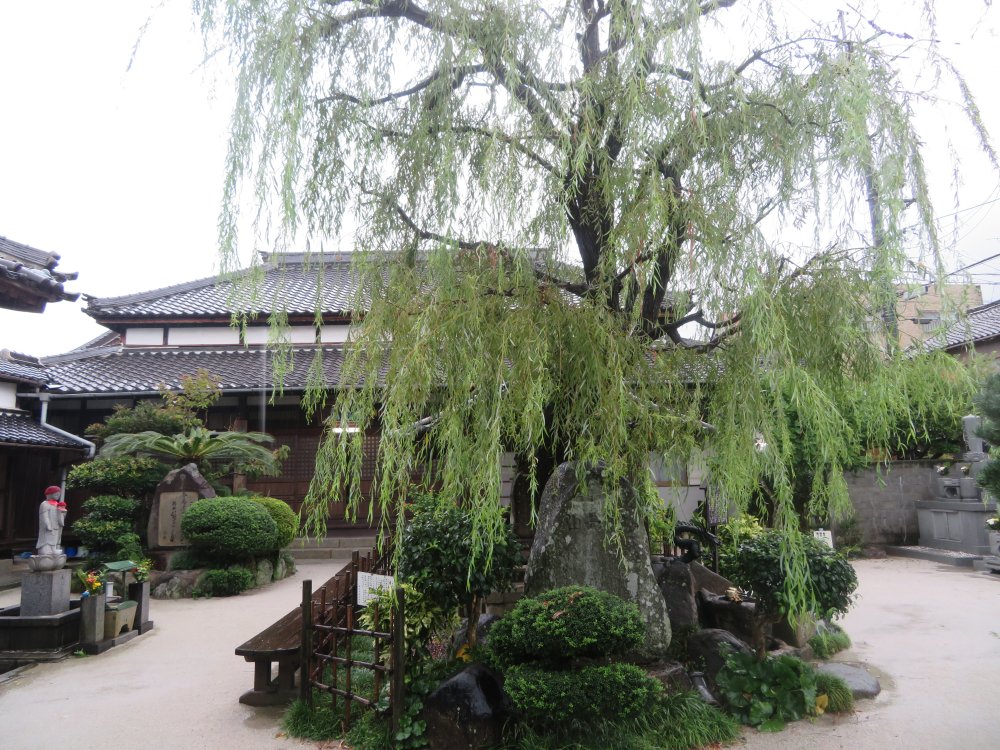
Inside Shoukouan, a Zen Buddhist temple you can see the willow and well which is the namesake of Yanai (willow well).
It was close to noon, and on top of the rain it had become windy. We decided
to flee back to Iwakuni and spend the rest of the day at the hotel enjoying
an early bath in the onsen. However the rain and wind had not yet reached
the Iwakuni area, so we went to see US Marine Corps Iwakuni Base on the
coast of Iwakuni. Following occupation by the allied forces after WWII,
what was formerly Japan Navy’s Iwakuni naval air station became a US military
base in 1952 as an airbase for the Korea War. I understand that the station
is home to more than five thousand military and related Americans. The
station is also shared with the Japanese Maritime Self Defense Force, and
recently become a shared public international airport, Iwakuni Kintaikyou
Airport. Iwakuni’s population excluding the air station is about a hundred fifty thousand so the portion of American citizens is quite large. My interest was to see how the Americans were blending with the local community. Contrary to my expectation, the shop district in front of the main entrance gate of the military base was rather small. However when we had lunch at a ramen noodle shop in the city center, we were surprised to see that almost half of the customers were American. For us Japanese it was quite amusing to see the customers enjoying ramen with fried rice which is perhaps the equivalent of having pizza, fried chicken and coke, but also encouraging as support to the local economy. The rainclouds were getting closer and it was raining heavily when we got back to Kintaikyou.
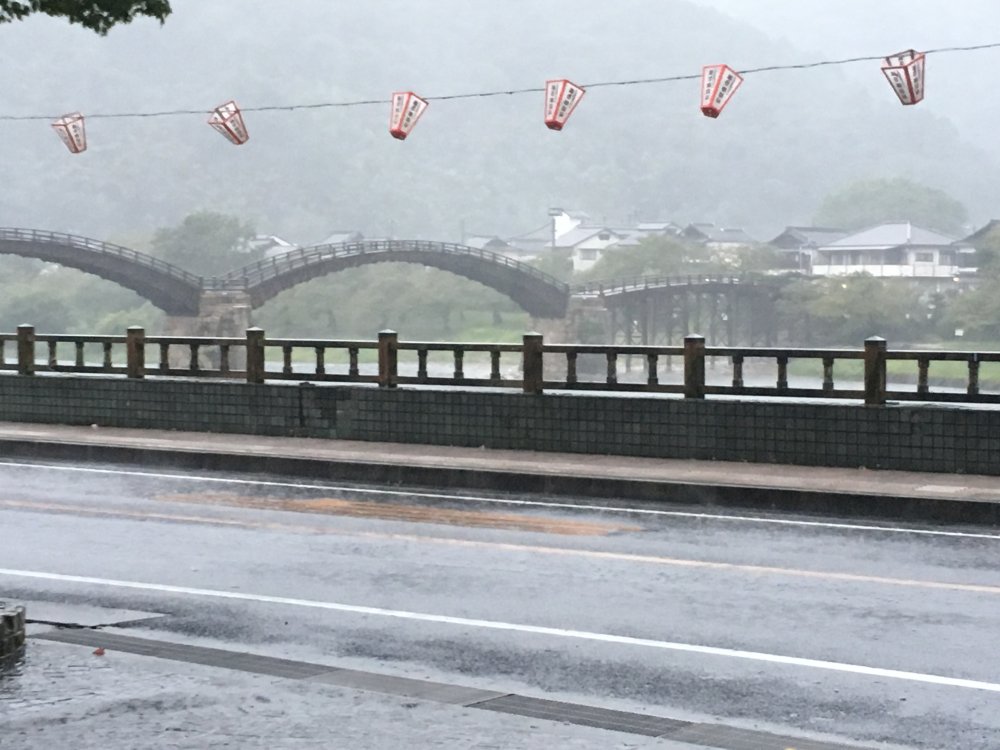
The rain and wind of typhoon No 18 had reached Kintaikyou.
Typhoons usually increase their speed once they have struck land. Typhoon
No.18 was no exception and by early morning the following day it had passed
the Chugoku area and was heading for Hokkaidou. Clear skies follow after
typhoons have left. It was a beautiful and quite warm day. It was an ideal
day to complete our tour of Iwakuni. We first visited the Kikkawa museum
which had been closed the previous day. The admission fee of five hundred
yen is expensive when you consider they only have one exhibition hall.
On display that day was correspondence related to Hiroie Kikkawa before
and after the historic battle of Sekigahara. Although there are English
summaries of the letters, it is difficult to grasp even for us Japanese
the exact circumstances these were delivered, so perhaps even less interesting
for visitors from abroad. We next visited the Mekata samurai residence
in front of the ropeway station. This is a residence of a middle ranking
samurai built in the middle of the eighteenth century. It is very well
preserved and will give you a good idea of Edo era samurai residences.
Unfortunately you can only view from the outside and gardens.
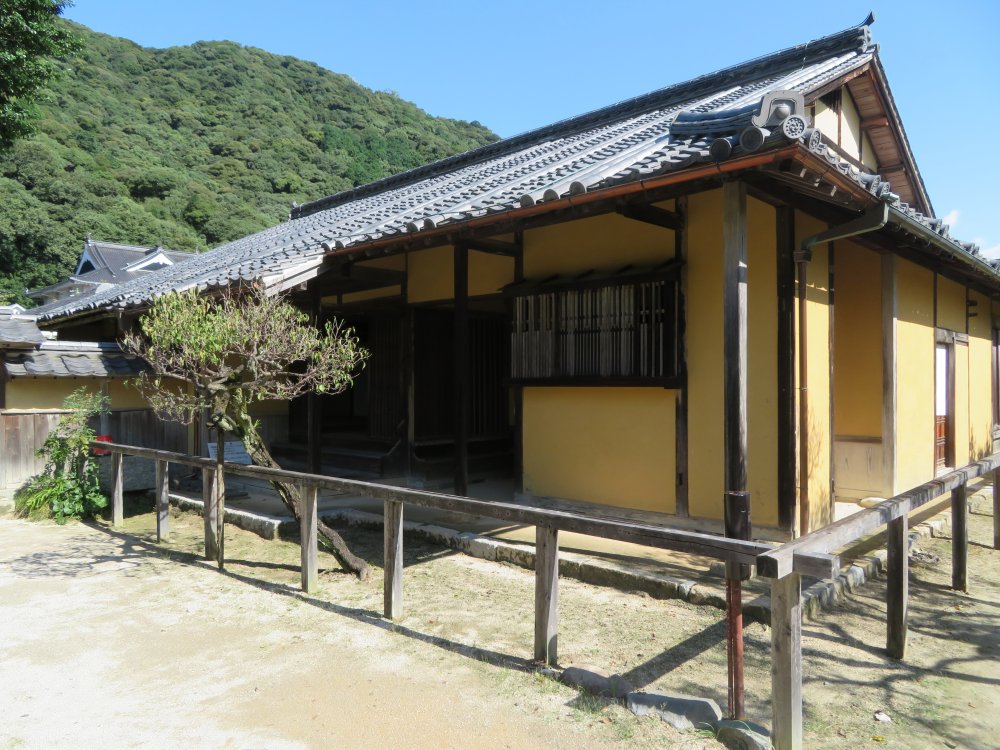
Mekata family residence is a good example of housing for medium rank samurais.
The ropeway will take only three minutes to take you up to the castle grounds.
Another ten minutes’ walk will take you to the reconstructed castle keep.
It’s a pity that it is only a reconstruction like many other castle keeps.
But I find it is usually worth the admission fee to take a look at the
displays and then command a beautiful view of the township. There were
a lot of swords displayed. I was reminded that the Chugoku area was home
to many sword makers as steel making from sand iron developed in the area.
I guess the display of swords may be appealing to those interested in samurai
swords.
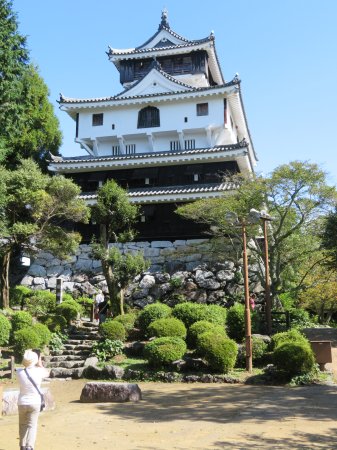
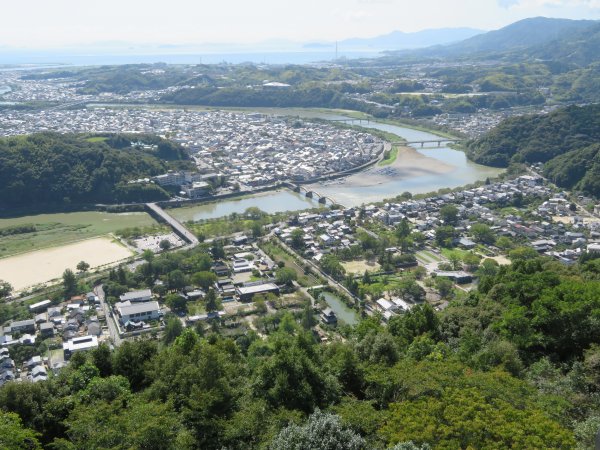
The restored keep of Iwakuni Castle (left) View from the top of the keeps gives you a good idea how Kintaikyou linked the castle and township. (right)
I didn’t forget to purchase local sake. I didn’t know until this visit
that there are five sake breweries in Iwakuni City. Particularly known
are the brands, Dassai which fetches a high premium, Gokyo (meaning five
bridges which comes from Kintaikyou with five arches) distributed nationally
followed by Gangi. I had planned to visit the oldest Horie Brewery established
in 1764, but had to abandon the idea because of the typhoon as the brewery
is located in the mountains more than twenty kilometers away from central
Iwakuni . I tried a couple of liquor shops but in all cases advised that
they had run out of stock. I suspect this may be because they have received
some international awards. It was very difficult to find modestly priced
local sake on this occasion. I avoid expensive daiginjou. Expensive sake
should be good. But the real joy comes when you discover quality local
sake reasonably priced. Between two to three thousand yen would be as much
as I would go. I managed to buy the last bottle of Gangi junmai “Hitotsubi.”
Although a junmai (100% rice) it is not that heavy and has a delightfully
smooth taste.
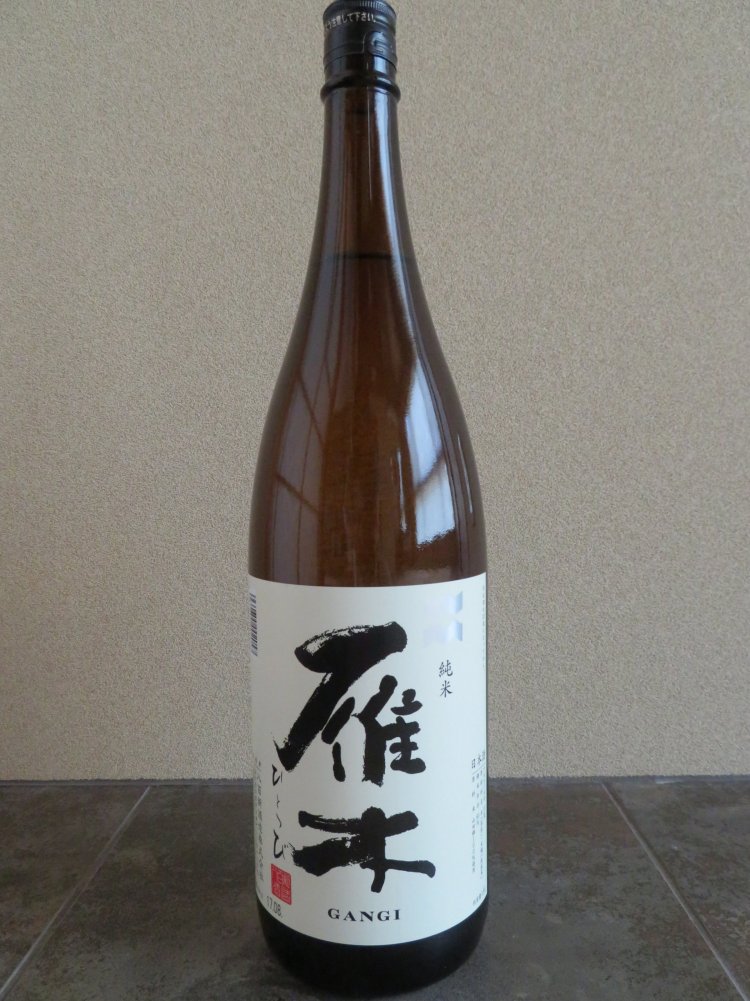
1.8 liter bottle of a junmai Gangi "Hitotsubi"